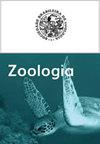带状罗非鱼(罗非鱼)消化道形态、组织学和组织化学研究(桡足目:慈鱼科)
IF 1.8
4区 生物学
Q4 ZOOLOGY
引用次数: 10
摘要
本研究描述了非洲南部特有的杂食性淡水鱼1840年罗非鱼(Tilapia sparrmanii Smith)消化道粘膜的解剖、组织学和组织化学特征。该物种具有短而厚的食道和长而深的纵向褶皱(466.68±16.91µm),以及厚的(173.50±10.92µm)肌肉层,允许大的食物通过。粘膜内衬层状分泌上皮,富含分泌中性和酸性粘蛋白的杯状细胞。胃为囊状结构,被结缔组织包围的简单管状腺体。粘膜内衬单层柱状上皮,固有层显示发育良好的胃腺层,占据整个心基底区。胃黏膜由大量分泌中性黏液的上皮细胞组成,对胃液有保护作用。胃腺颈部细胞合成中性和酸性粘蛋白。肠高度盘绕,内部呈现复杂的横向褶皱(绒毛)。绒毛长度从前肠到后肠逐渐减少(p < 0.0001)。中肠肌层厚度最薄(p < 0.0001)。向直肠方向数量增加的杯状细胞分泌酸性和中性黏蛋白。结果表明,T. sparrmaniiGIT与其他罗非鱼物种结构相似,将有助于了解消化系统的生理学以及GIT的功能成分。本文章由计算机程序翻译,如有差异,请以英文原文为准。
Morphology, histology and histochemistry of the digestive tract of the Banded tilapia, Tilapia sparrmanii (Perciformes: Cichlidae)
This study described anatomical, histological and histochemical features of the mucosal layer of the digestive tract of Tilapia sparrmanii Smith, 1840, an omnivorous freshwater fish endemic to Southern Africa. This species exhibited a short thick oesophagus with long deep longitudinal folds (466.68 ± 16.91 µm), and a thick (173.50 ± 10.92 µm) muscular layer that allow the passage of large food items. The mucosa was lined with stratified secretory epithelium rich in goblet cells that secreted neutral and acid mucins. The stomach was a sac-like structure with simple tubular glands surrounded by connective tissue. The mucosa was lined with simple columnar epithelium and the lamina propria exhibited a well-developed layer of gastric glands that occupied the entire length of the cardio-fundic region. The stomach mucosa consisted of epithelial cells with intense neutral mucin secretion which protects against gastric juice. Neck cells of gastric glands synthesized neutral and acid mucins. The intestine was highly coiled and presented a complex pattern of transversal folds internally (villi). Villi length decreased progressively from the anterior to the posterior intestine (p < 0.0001). Tunica muscularis of the mid-intestine had the thinnest thickness among all parts of the intestine (p < 0.0001). Goblet cells whose numbers increased towards the rectum secreted both acid and neutral mucins. The results indicate structural similarities of T. sparrmaniiGIT with other tilapia species and will be useful for understanding the physiology of the digestive systems as well as functional components of the GIT.
求助全文
通过发布文献求助,成功后即可免费获取论文全文。
去求助
来源期刊

Zoologia
生物-动物学
自引率
0.00%
发文量
15
期刊介绍:
Zoologia, the scientific journal of the Sociedade Brasileira de Zoologia (SBZ), is an international peer-reviewed, open-access Zoological journal that publishes original research on systematics, evolution, taxonomy, nomenclature, biogeography, morphology, physiology, biology, ecology, symbiosis, conservation, behavior, genetics and allied fields. The journal, formerly known as Revista Brasileira de Zoologia, publishes original articles authored by both members and non-members of the Society. The manuscripts should be written exclusively in English.
 求助内容:
求助内容: 应助结果提醒方式:
应助结果提醒方式:


